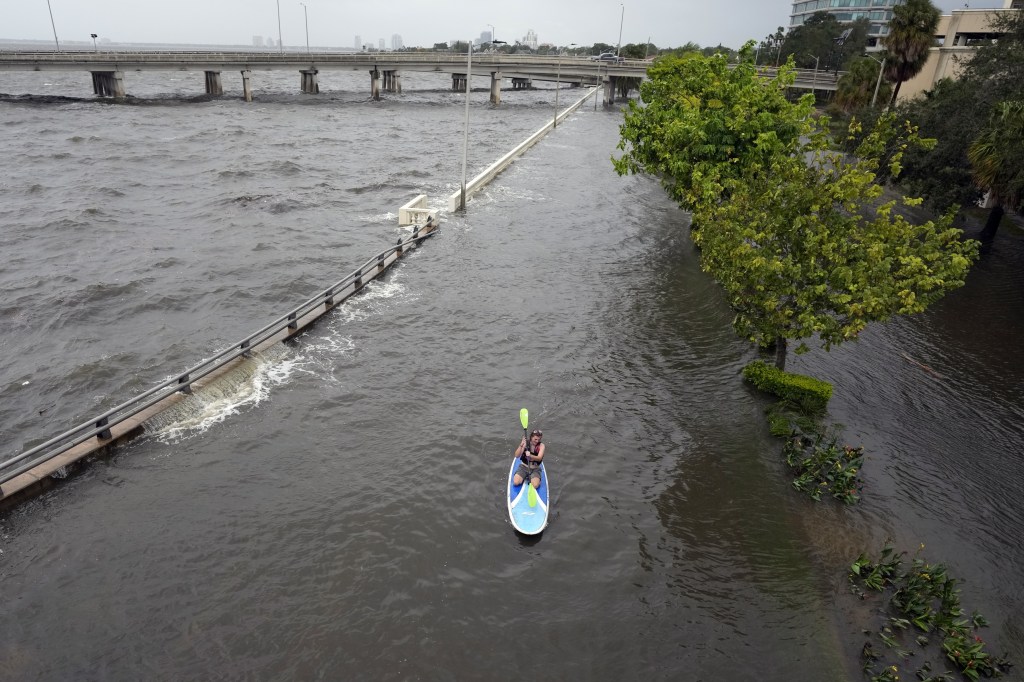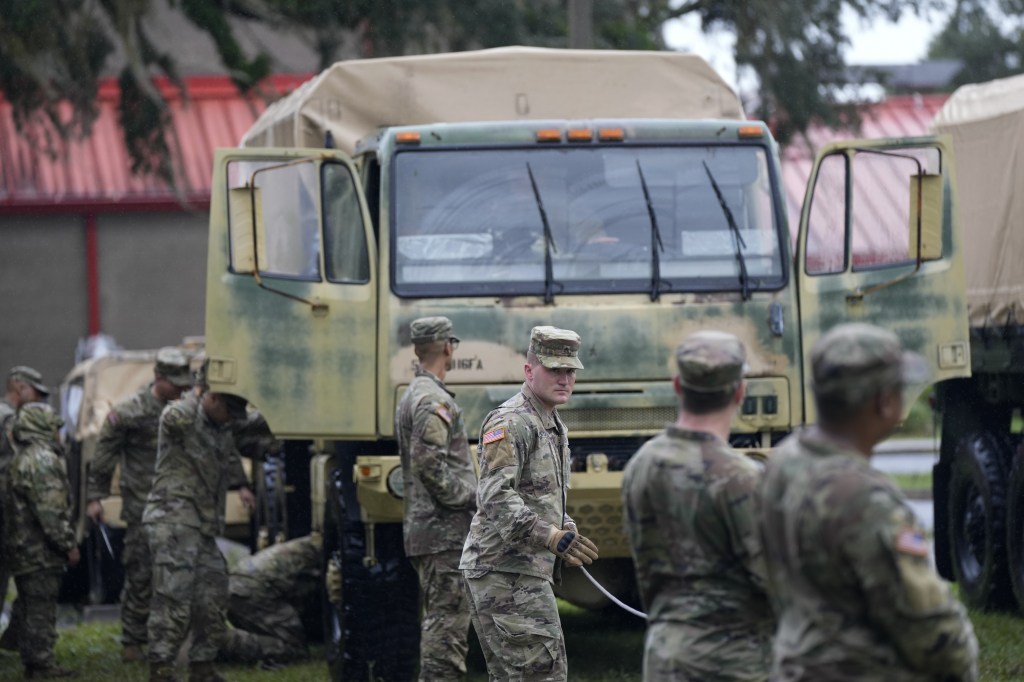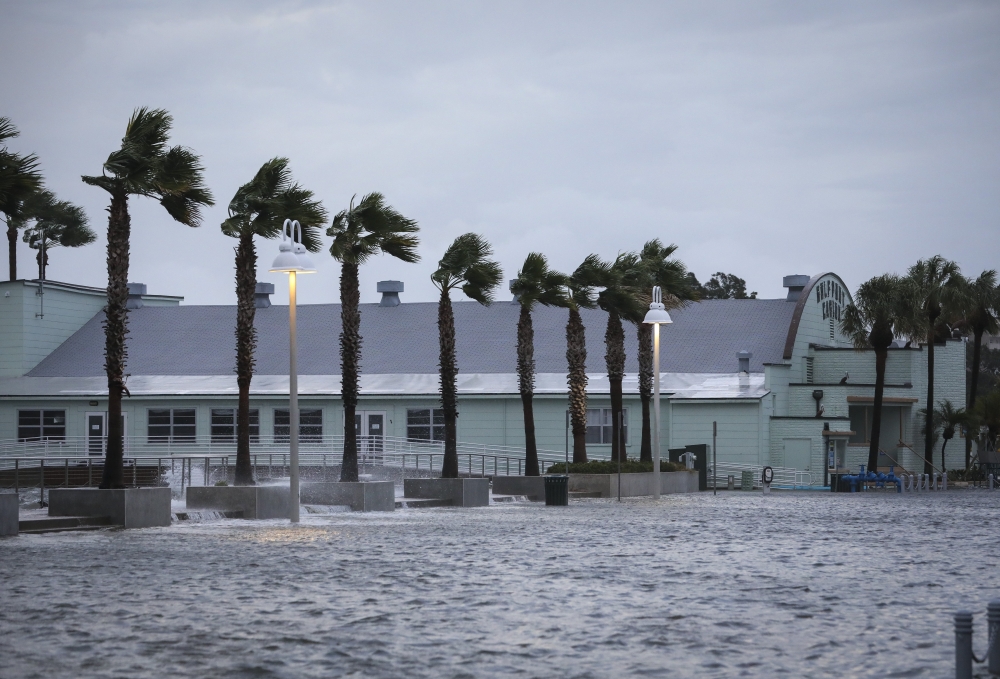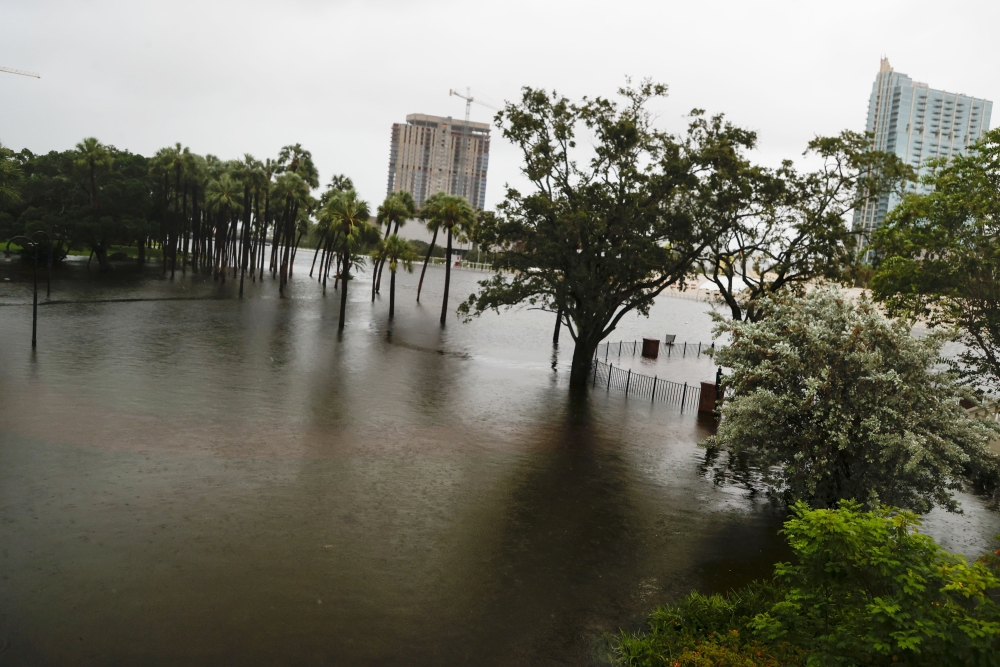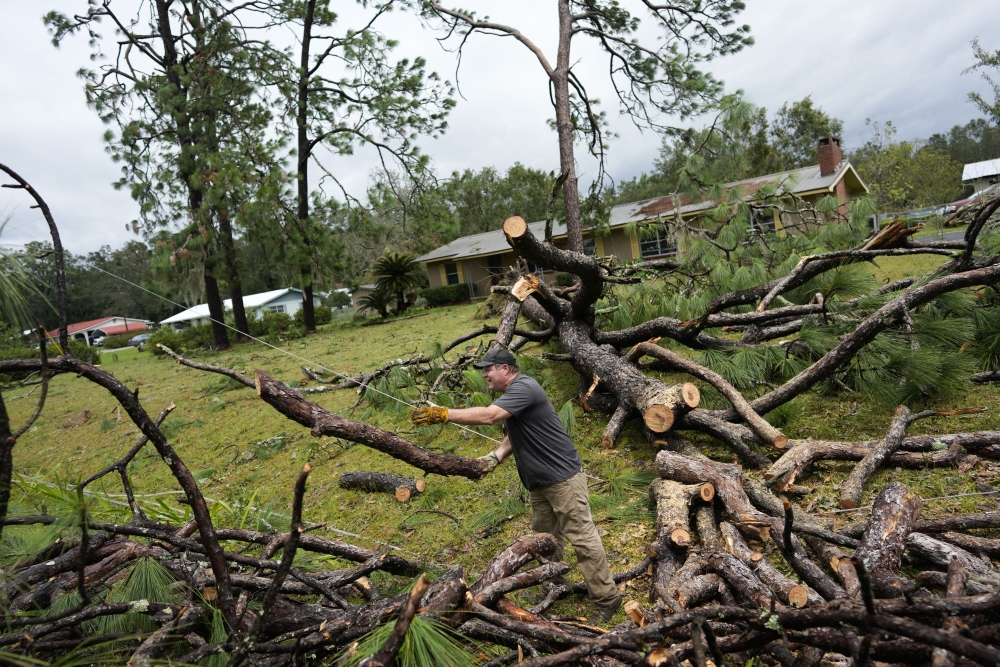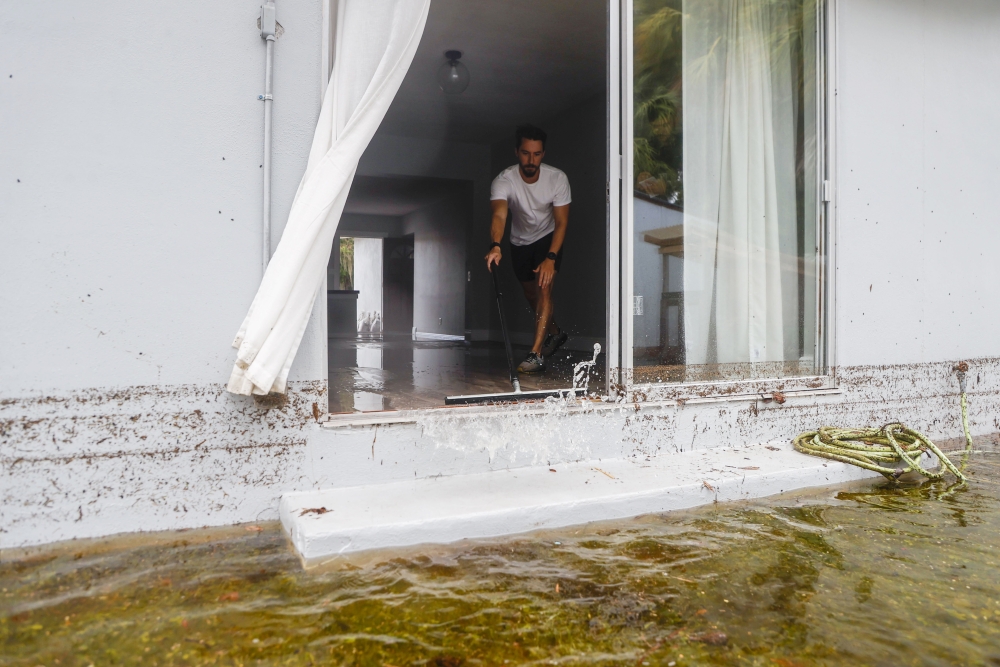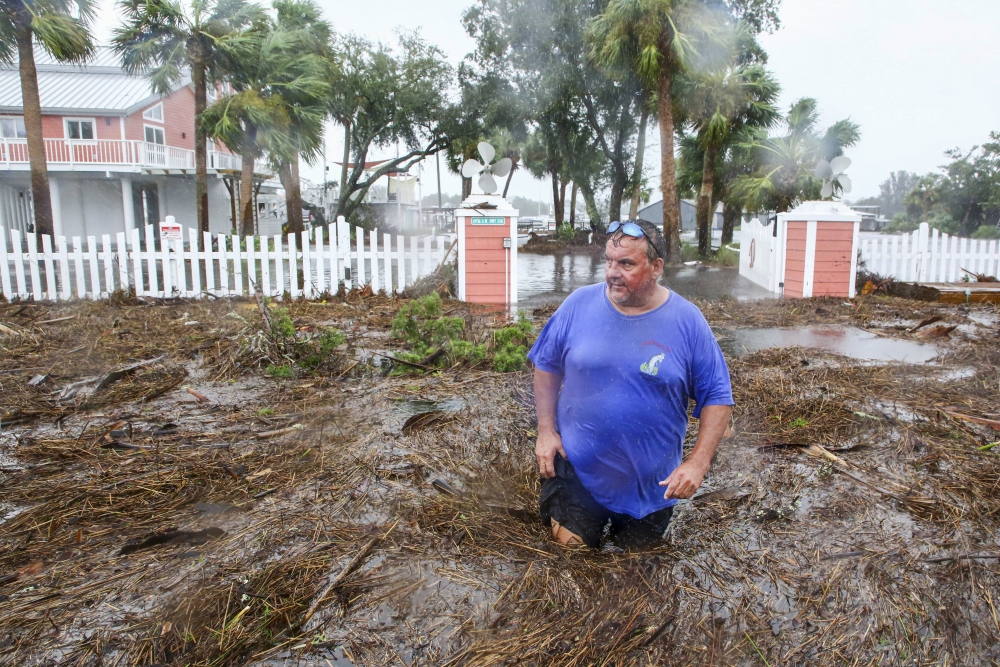PERRY, Fla. — Hurricane Idalia tore into Florida at the speed of a fast-moving train Wednesday, splitting trees in half, ripping roofs off hotels and turning small cars into boats before sweeping into Georgia and South Carolina as a still-powerful storm that flooded roadways and sent residents running for higher ground.
“All hell broke loose,” said Belond Thomas of Perry, a mill town located just inland from the Big Bend region where Idalia came ashore.
Thomas fled with her family and some friends to a motel, thinking it would be safer than riding out the storm at home. But as Idalia’s eye passed over about 8:30 a.m., a loud whistling noise pierced the air and the high winds ripped the building’s roof off, sending debris down on her pregnant daughter, who was lying in bed. Fortunately, she was not injured.
“It was frightening,” Thomas said. “Things were just going so fast. … Everything was spinning.”

Daniel Dickert wades through water in front of his home where the Steinhatchee River overflowed on Wednesday, in Steinhatchee, Fla., after the arrival of Hurricane Idalia. Douglas R. Clifford/Tampa Bay Times via AP
After coming ashore, Idalia made landfall near Keaton Beach at 7:45 a.m. as a high-end Category 3 hurricane with maximum sustained winds near 125 mph. The system remained a hurricane as it crossed into Georgia with top winds of 90 mph. It weakened to a tropical storm by late Wednesday afternoon, and its winds had dropped to 60 mph by Wednesday night.
As the eye moved inland, high winds shredded signs, blew off roofs, sent sheet metal flying and snapped tall trees. One person was killed in Georgia. No hurricane-related deaths were officially confirmed in Florida, but the Florida Highway Patrol reported two people dying in separate weather-related crashes just hours before Idalia made landfall.
The storm brought strong winds to Savannah, Georgia, Wednesday evening as it made its way toward the Carolinas. It was forecast to move near or along the coast of South Carolina through Wednesday night and then just off the coast of North Carolina on Thursday before heading out into the Atlantic Ocean.
Idalia spawned a tornado that briefly touched down in the Charleston, South Carolina, suburb of Goose Creek, the National Weather Service said. The winds sent a car flying and flipped it over, according to authorities and eyewitness video. Two people received minor injuries.
Along South Carolina’s coast, North Myrtle Beach, Garden City, and Edisto Island all reported ocean water flowing over sand dunes and spilling onto beachfront streets Wednesday evening. In Charleston, storm surge from Idalia topped the seawall that protects the downtown, sending ankle-deep ocean water into the streets and neighborhoods where horse-drawn carriages pass million-dollar homes and the famous open-air market.

This satellite image from Wednesday at 11:21 a.m. shows Hurricane Idalia, center, over Florida and crossing into Georgia, and Hurricane Franklin, right, as it moves along off the East coast of the United States. National Oceanic and Atmospheric Administration via Associated Press
Preliminary data showed the Wednesday evening high tide reached just over 9.2 feet, more than 3 feet above normal and the fifth-highest reading in Charleston Harbor since records were first kept in 1899.
Florida had feared the worst while still recovering from last year’s Hurricane Ian, which hit the heavily populated Fort Myers area, leaving 149 dead in the state. Unlike that storm, Idalia blew into a very lightly inhabited area known as Florida’s “nature coast,” one of the state’s most rural regions that lies far from crowded metropolises or busy tourist areas and features millions of acres of undeveloped land.
That doesn’t mean that it didn’t do major damage. Rushing water covered streets near the coast, unmoored small boats and nearly a half-million customers in Florida and Georgia lost power. In Perry, the wind blew out store windows, tore siding off buildings and overturned a gas station canopy. Heavy rains partially flooded Interstate 275 in Tampa and wind toppled power lines onto the northbound side of Interstate 75 just south of Valdosta, Georgia.
Less than 20 miles south of where Idalia made landfall, businesses, boat docks and homes in Steinhatchee, Florida, were swallowed up by water surging in from Deadman’s Bay. Police officers blocked traffic into the coastal community of more than 500 residents known for fishing and foresting industries.
State officials, 5,500 National Guardsmen and rescue crews were in search-and-recovery mode, inspecting bridges, clearing toppled trees and looking for anyone in distress.
Because of the remoteness of the Big Bend area, search teams may need more time to complete their work compared with past hurricanes in more urban areas, said Kevin Guthrie, director of the Florida Department of Emergency Management.

President Biden, center, delivers remarks on recovery efforts for the Maui wildfires and the response to Hurricane Idalia, in the Roosevelt Room of the White House on Wednesday, in Washington. Joint Chiefs Chairman Gen. Mark Milley, left, Secretary of Defense Lloyd Austin, Homeland Security Secretary Alejandro Mayorkas, and Federal Emergency Management Agency administrator Deanne Criswell stand behind Biden. Evan Vucci/Associated Press
“You may have two houses on a 5-mile road so it’s going to take some time,” Guthries said.
The National Weather Service in Tallahassee called Idalia “an unprecedented event” since no major hurricanes on record have ever passed through the bay abutting the Big Bend.
On the island of Cedar Key, downed trees and debris blocked roads, and propane tanks exploded.
RJ Wright stayed behind so he could check on elderly neighbors. He hunkered down with friends in a motel and when it was safe, walked outside into chest-high water. It could have been a lot worse for the island, which juts into the Gulf, since it didn’t take a direct hit, he said.
“It got pretty gnarly for a while, but it was nothing compared to some of the other storms,” Wright said.
In Tallahassee, the power went out well before the center of the storm arrived, but the city avoided a direct hit. A giant oak tree next to the governor’s mansion split in half, covering the yard with debris.

People kayak past an abandoned vehicle in the intersection of Boca Ciega Drive and Pasadena Avenue on Wednesday in St. Pete Beach, Fla. Chris Urso/Tampa Bay Times via Associated Press
In Valdosta, Georgia, Idalia’s fierce winds uprooted trees and sent rain flying sideways. Jonathon Wick said he didn’t take the approaching hurricane seriously until Wednesday morning, when he awoke to howling winds outside his home. After rescuing his young nephews from a trampoline in their back yard where the water rose to his knees, he brought them to his car and was climbing into the driver’s seat when a tree toppled right in front of the vehicle.
“If that tree would have fell on the car, I would be dead,” said Wick, who ended up getting rescued by another family member.
One man was killed in Valdosta when a tree fell on him as he was trying to clear another tree out of the road Wednesday, said Lowndes County Sheriff Ashley Paulk. Two others, including a sheriff’s deputy, were injured when the tree fell, Paulk said.
More than 30,000 utility workers in Florida were gathering to make repairs as quickly as possible in the hurricane’s wake. Airports in the region, including Tampa International Airport, planned to restart commercial operations either Wednesday afternoon or Thursday. By midday Wednesday, more than 900 flights had been canceled in Florida and Georgia, according to tracking service FlightAware.
At 11 p.m. EDT Wednesday, Idalia was about 15 miles north-northwest of Charleston, the National Hurricane Center said. It was moving northeast at 21 mph.
Officials in Bermuda warned that Idalia could hit the island early next week as a tropical storm. Bermuda on Wednesday was being lashed by the outer bands of Hurricane Franklin, a Category 2 storm that was on track to pass near the island in the north Atlantic Ocean.
President Biden called the governors of Florida, Georgia, North Carolina and South Carolina on Wednesday and told them their states had his administration’s full support, the White House said.
Associated Press writers Mike Schneider in St. Louis, Missouri; Curt Anderson in Orlando, Florida; Laura Bargfeld and Chris O’Meara in Tampa, Florida; David Fischer in Miami Beach; Russ Bynum in Savannah, Georgia; Jeff Amy and Jeff Martin in Atlanta; Lisa J. Adams Wagner in Evans, Georgia; Jeffrey Collins in Columbia, South Carolina; Kathy McCormack in Concord, New Hampshire; Christopher Megerian in Washington; and Julie Walker and David Koenig in Dallas contributed to this report.
Comments are not available on this story.
Send questions/comments to the editors.







